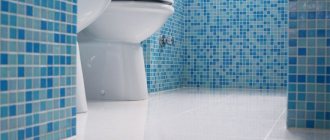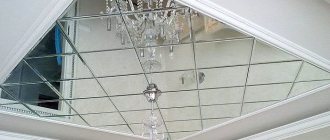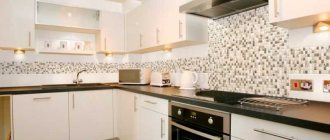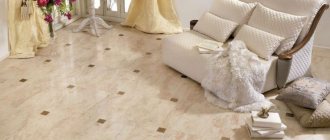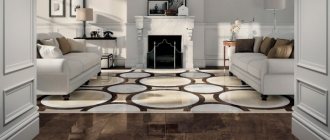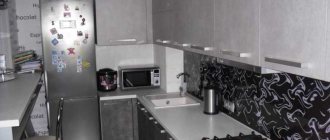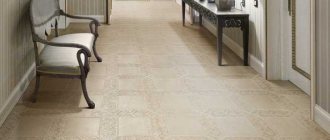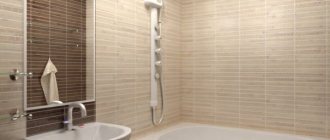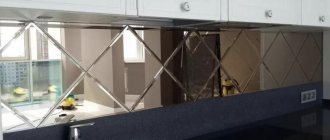Mosaic is a beautiful and unique material with a long history. Since ancient times, the most status and important rooms have been decorated with it. Today, to simplify installation, it is produced on special meshes measuring approximately 30x30 cm. Thanks to its flexibility, any shape can be lined with this material. Mosaics on mesh can be made of glass, porcelain stoneware, stone and other materials. It can be a single color, a mixture or a pattern. Modern mosaic variety cannot fail to impress!
- Glass mosaic
- Stone mosaic
- Mosaic made of ceramics and porcelain stoneware
- Where is mosaic on a grid used?
- Materials for creating a decorative surface
- Types of matrices of mosaic compositions
- Caring for mosaics Working with natural stone modules
- Preparing the base
- Laying mosaics on a grid
Glass mosaic
Glass mosaic tiles are a universal material. It can be installed in wet areas, indoors, outdoors and in swimming pools. It is durable and does not lose its aesthetic properties under the influence of time or the external environment. Glass mosaics have a wide color palette - right up to gold and mirror tiles! Glass mosaic tiles magically transform when light hits them, making the canvas play with new colors and enchanting reflections. It can also be translucent. The size of mosaic chips on a grid is usually 1-2 cm, but there are also large chips measuring 5 cm. The technology for laying glass mosaics is not much different from ceramic ones, with the exception of some necessary tools - special glue is needed for glass mosaics.
Stone mosaic
This material has many types: marble mosaic on a grid, pebble mosaic on a grid, pebble mosaic, granite mosaic, travertine. You can also find other pebbles on the grid! Stone mosaic is a durable material that can be safely laid on the floor. Natural pebbles on a grid create a feeling of unity with nature. Even small pebbles look aesthetically pleasing and expensive. However, the color palette and overall variety are much inferior to other types of mosaics. This kind of mosaic is expensive and quite difficult to maintain.
Mosaic in the kitchen
Tile finishing in the kitchen is also very popular due to the technical characteristics of the material and the ease of care for it. In the kitchen, mosaic tiles are most often used to lay out the backsplash.
You can lay out the mosaic elements in a checkerboard pattern, using harmoniously combined colors and shades, or you can create a unique pattern, design, or ornament.
Mosaics can also be laid on the floor, highlighting the dining area, or decorate a tabletop or part of a wall.
Mosaic made of ceramics and porcelain stoneware
Ceramic mosaic tiles on a grid differ from porcelain tiles in that the first, as a rule, is intended only for wall installation, while the second is universal. Modern manufacturers of ceramics and porcelain stoneware can give this material any appearance: marble, stone, wood, concrete or even metal. This also applies to mosaics. The choice of colors, shapes, sizes and patterns is almost limitless. It can be matte or glossy. Wall mosaics often use decorative inserts made of gilding, glass or metals. The only thing that ceramics and porcelain stoneware cannot control is the translucency of the chips.
Where is mosaic on a grid used?
The scope of mosaic is wide. If ceramic mosaics are suitable only for interior decoration, then porcelain stoneware, glass and stone can be used literally everywhere. It is only important to follow the recommendations for glue and grout for a specific room - the wrong choice can ruin all your efforts. This material is not afraid of moisture and, thanks to the seams between the chips, is not very slippery. Therefore, mosaics are often used in bathrooms, swimming pools, saunas and hammams. However, mosaic tiles also go well with kitchens, living rooms, and public areas. Fragments of this finishing material feel great when placed on the most complexly shaped surfaces. It would be an incredible stylish solution to decorate the entire interior of the room with mosaics, leaving only the doors!
Choosing mosaic color
In order to still choose some finishing material, you should consider options for its use by color.
Multicolored mosaic
A riot of colors for decorating a bathroom is also welcome. You can use both mixes and alternating monochromatic zones with colored ones. Let's look at the general impression that multi-colored mosaic tiles produce.
The combination of bright colors creates a positive mood PHOTO: dafix.ru
Golden tones look festive and, at the same time, somewhat official and representative PHOTO: eto-vannaya.club
Gray tones are often chosen for modern styles or bachelor pads PHOTO: design-homes.ru
The combination of tiles and mosaics in cream, pastel, and peach colors makes the bathroom look delicate PHOTO: interra-forum.ru
The coffee tones and brown palette are elegant and pair well with white, beige and green. Purple goes with pink, white, lilac, mint. But as the main color it does not have a depressing effect.
The blue palette has always been considered the most suitable for bathroom decor PHOTO: designmyhome.ru
White mosaic in the bathroom
White color is used as a setting tone. This is not only an ideal base for other tones, but also an independent color solution that deserves attention. True, if you include too much white in the design, you can accidentally ruin the whole impression.
Such white can be considered royal PHOTO: interiorno.ru
The combination of glossy and matte elements gives an interesting refreshing effect PHOTO: stroy-podskazka.ru
Smalt options will fill the bathroom with pleasant light PHOTO: archiexpo.com.ru
Materials for creating a decorative surface
Today, for ease of installation, the mosaic is attached to a special flexible mesh measuring approximately 30 by 30 centimeters. The mesh for mosaic tiles can be metal or plastic. In some cases, paper is used instead of a grid. In this case, the mosaic is laid with the paper facing out, after which, once wet, it is easily separated from the front surface of the material.
Types of matrices of mosaic compositions
Mosaic matrices are special panels with recesses for mosaics, on which you can create mosaic mixtures and panels. Preliminary layout of the material on the matrix allows you to evaluate the features of the combination of different colors and textures. Once the panel element or mixture is approved, the mosaic from the matrix can be transferred to paper or grid. There are two types of matrices: for mesh and for paper.
Mosaic design options in the bathroom with photo examples
Before you start choosing a finishing material, it makes sense to look at the features of different cladding in the photo.
Single color and background mosaic
Single-color products are purchased for modern styles such as minimalism. The standard colors there will seem motley and out of place.
It turns out cozy PHOTO: modernplace.ru
You can choose single-color parts in the form of hexagons PHOTO: russian.alibaba.com
A single-color mosaic becomes the background; the color can be any PHOTO: mosplitka.ru
Beautiful noble finish PHOTO: modernplace.ru
You can successfully make an accent with a one-color mosaic in the form of a stripe or pattern. This will play a certain role in the perception of the proportions of the room.
Mosaic gradient and mix
A gradient is a smooth flow of shade from dark to light, from bright to pale, from one color to another. This is an original approach to decorating a bathroom. The effect of stretching the room is obtained.
Color gives its effect PHOTO: pinterest.at
You can successfully decorate a shower stall PHOTO: archidea.com.ua
The color of the banner can be any PHOTO: obustroeno.com
Different colors are selected for the mix, but they are placed at random on the matrix PHOTO: obi.ru
Mosaic panel
The panel will be a bright and effective accent in the room, but its creation can only be accomplished with a high level of skill as a tiler. The parts are not located on the matrix, but are laid out manually.
Let's admire the photo of mosaic tiles for the bathroom in the form of a panel:
PHOTO: pinterest.ru
PHOTO: modernplace.ru
PHOTO: ivd.ru
PHOTO: assz.ru
PHOTO: sovety-vannoy.ru
PHOTO: mr-build.ru
Bathroom design with mosaic and full-size tiles
Combining finishing options is not only possible, but also necessary. Mosaic and full tile combinations are amazing. Since the sizes of the slabs are different, you can create something original and unique.
Select colors close to the palette. The photo shows a combination of mosaics and tiles in the bathroom PHOTO: piorit.ru
Beautiful mosaic edging PHOTO: tavannaya.ru
Mosaic care
Glass, ceramic and porcelain tile mosaics do not require special care tips. They are resistant to most types of cleaning agents, strong and durable. However, if you choose the wrong glue and grout, mold may begin to form. Then you will have to wipe the wet mosaic dry each time and thoroughly ventilate the room. To avoid this, don’t be lazy to choose anti-fungal grout!
Working with natural stone modules
As for mosaics made of natural stone, they require special care. Of the different types of stone mosaics, granite positions are the most durable. But the most popular stone is, of course, marble. To clean it, you can only use special cleaning products designed for wiping natural stones. You should try to remove most of the dirt from the stone as early as possible so that the pigment does not have time to be absorbed into the mosaic and remain there forever.
Mosaic cladding: all the subtleties of installation
2014-09-30 Author: Vera Category: Ceramics and mosaics Views: 10885
Today, despite the huge selection of finishing materials, mosaic cladding is the most common. This is due to the fact that it has an unusual appearance and excellent properties and characteristics.
Mosaic in the interior
Varieties of mosaic finishing
Mosaic finishing has been very popular for many years. It looks original on the surface due to its non-standard size.
There are several types of facing mosaics that are used in finishing work on the surface:
- Ceramic.
- Stone (natural and artificial).
- Glass.
- Metal.
Note : Do you need high-quality, comfortable and useful massagers? We recommend paying attention to the Rongtai brand. Wide selection of models and very low prices!
Where can mosaic finishing be used?
Cladding with mosaic material can be done on any surface. Quite often used for this type of finishing:
- Walls.
- Kitchen aprons.
- Floor.
- Decorative and working fireplaces or stoves.
The most important thing is that the surface is smooth and prepared for installation of the material (see Mosaic finishing and areas of application).
Ceramic mosaic and its properties in finishing
Properties of ceramic tiles
The very first to use was facing surfaces with ceramic mosaics. The material is made from clay dough and goes through several stages of processing.
There are two options for applying a pattern or simple color design to the surface:
- Under the influence of high temperatures with one firing.
- Under the influence of high temperatures with double firing.
Note. Both types of ceramic mosaic have high strength and reliability. The material is practical and durable, and is not capable of changing its appearance throughout its entire service life.
The color range of ceramic mosaics is quite wide, its surface can be:
- Glazed or matte.
- Structured or smooth.
Wall cladding with ceramic mosaics is done with tiles of the following sizes:
- 10x10 mm.
- 20x20 mm.
- 30x30 mm.
There are sheets of mosaic material, which are a mesh with a standard ceramic tile size of 20x30 cm, onto which small mosaic tiles are glued.
Quite often, fireplaces are faced with ceramic mosaics. This is due to the fire resistance and attractiveness of the material. With this finish it will be easy to choose the desired color scheme for the surface.
Advice. To ensure that kitchen walls are covered with mosaics quickly and efficiently, it is best to use sheet material of this type (mosaic glued to a mesh).
Mosaic material made of natural and artificial stone
Photo of mosaic stone in the interior
Surface cladding with natural stone mosaics is not used as often as with decorative materials. All this is due to the high cost of the material.
Mosaic can be made from the following natural agglomerates:
- Granita.
- Onyx.
- Sandstone.
- Shell rock.
- Marble.
Material characteristics:
- This type of mosaic material can be used to decorate floor surfaces, as it has high strength and durability.
- Wall cladding with artificial stone mosaics is no less attractive. It has a fairly reasonable price.
Advice. Mosaic material made from artificial stone is not recommended for finishing floor surfaces, since it does not have high strength and under the influence of heavy load its structure will become deformed.
- Wall cladding made of mosaics (artificial stone) is very popular. The material does not require special care and its surface is practical and durable.
Advice. To protect the surface of the artificial stone from the effects of moisture and other things, it is worth covering it with a transparent varnish and thus the service life of the material will increase.
Artificial mosaic and natural agglomerate have several differences. Natural mosaic tiles for wall cladding have a lot of weight, but artificial stone tiles do not. This causes differences in the installation of materials.
Features of installing mosaic stone
Installation of mosaic stone
The technology of cladding with natural stone mosaics involves preliminary strengthening of the surface for installation. For this purpose, special reinforcing or wire mesh is used, which are initially fixed to the surface and only then plaster or concrete solutions are applied to them.
Carrying out work:
- With the installation of mosaic material made of artificial stone, such work will not be required. The most important thing is to make a flat surface before mounting. The work process is quite simple and all of them can be done with your own hands.
- To do this you will need a solution of concrete or plaster. It all depends on what kind of building material the surface is constructed from. If it is a brick, then it is best to use a concrete solution, which can give strength to the fixing of the finish.
- Carpet mosaic cladding is done only with natural agglomerate. It is able to withstand any load. The installation process on a floor surface is similar to installation on a wall surface.
- The plane must be level and well primed. A concrete solution is almost always used for fixing to the surface.
- The fireplace can also be faced with mosaics made of natural or artificial stone. It is used to decorate the portal outside and for the firebox inside. This is due to the fact that the material does not ignite under the influence of a direct fire source and is able to withstand high temperatures.
Advice. A black coating remains on the surface of the mosaic material during the combustion process. You can remove it with a simple detergent and a wire brush.
In a similar way, stoves are lined with mosaics made of artificial or natural stone, which work. Here the surface must be insulated with asbestos mortar, since ordinary concrete mortar or plaster is not able to withstand constant high temperatures and their structure begins to deform.
Glass mosaic in surface finishing
Interior decoration using glass mosaic
This type of mosaic coating can only be used on vertical surfaces. Although it has high strength, it is not able to withstand heavy loads.
Features and Specifications:
- Glass mosaic tiles are most often used in the living room. It is used to finish individual wall elements. You can also use glass mosaic in the kitchen. Only she requires special care.
- The material is made from high-strength and fire-resistant glass. During the production process, glass is melted and various coloring pigments are added to it, which give the surface a color design.
Advice. It is not recommended that the stove be lined with glass or fireplace mosaics. The material is not able to withstand fairly high temperatures and begins to crack and change its appearance under the influence of them.
Glass mosaic is moisture resistant and can be used in rooms with high air humidity. It is attached to the surface using special glue.
Metal mosaic in surface finishing
Interior design using metal mosaics
Metal mosaic material is quite often used for exterior finishing work. But, despite this, it is also widely used in interior decoration. Metal mosaic fireplace cladding is also common.
Features and characteristics of the material:
- The size of the material may vary. There are no tiles too small here. Their size can be 10x10 cm and so on. You can find parameters of 5x5 cm. Metal mosaic is made from a thin stainless steel sheet.
- The material does not have much weight, and due to this there will be no need to reinforce the surface for its installation.
- Moisture resistance and attractive appearance are two main characteristics of metal mosaic. It is securely fixed to the surface using concrete mortar or special fasteners, which are presented in the form of a frame. The mosaic tiles are thus assembled into panels and only then secured with self-tapping screws or rivets.
Note. The price of the material is quite high. The surface of a metal mosaic can be glossy or matte. It is coated with polymer paint, which can not only give shine to the surface, but also a certain relief structure. The colors of the material are quite varied.
How to install mosaic material on a surface
For the installation of any mosaic material there are specific instructions for action. It consists of leveling the surface, since the back side, which serves as the basis for fixing the material, is flat, and priming, which is performed with a special means - primer.
You can level the surface using:
- Concrete mortar.
- Plasters.
- Drywall.
Advice. To install mosaics made from natural agglomerate, you should not use plasterboard, since its sheet is not able to withstand heavy finishing loads. Concrete mortar is suitable for this type of mosaic material.
- Before covering the walls with mosaics, they must be cleaned and primed. The surface can be cleaned using simple detergents.
Advice. If there are fungal diseases or rust on the surface, then it is necessary to get rid of them.
Mosaic cladding - all the subtleties of installation lie in the correct selection of means for fixing the material. The most rational solution would be a concrete solution, which is suitable for any type of mosaic covering. The installation of the mosaic can be seen in the video.
Laying technology
How to properly lay mosaic tiles on a grid? Installation can be done with your own hands. First you need to select tools and finishing materials. Calculate the required amount of glue and grout. Prepare the base to which you will glue the mosaic on the grid. Laying mosaic tiles with your own hands requires meticulous preparation! You will need the following tools:
- Glue mixing container and construction mixer
- Building level
- Regular rubber spatula (rubber)
- Notched trowel
- Roller
- Deep penetration primer for base
- Glue suitable for the type of room
- Grout with similar properties
- Sponge
Preparing the base
The walls or floors that will be covered with mosaics must be perfectly smooth. Large depressions will need to be filled with drywall or plaster. Otherwise, the mesh will lie crookedly and the drawing will be distorted. The integrity of the mosaic canvas will be compromised. In case of a large number of irregularities in the original base, it is necessary to use an elastic composition of mosaic adhesive. Surfaces exposed to dampness must be covered with antifungal materials.
Surface cleaning
If the repair is not carried out from scratch, but in an area that was once lined with other materials, the following steps must be taken. It is imperative to clean the surface from dirt and old coatings. The plaster can be left if it does not crumble. If it crumbles, then remove it too. If the base is completely crooked, then it is better to create a new base from plasterboard.
Wall marking
Marking the walls is carried out after leveling and applying a layer of primer (and its drying). To begin with, it is worth making a “dry layout” without using glue. Thanks to this measure, it will be possible to avoid unpleasant surprises during finishing installation. We choose where to start laying. The best option would be to do it from top to bottom. After dry laying out, the mosaic elements are signed or secured with tape. Next comes the actual styling. It is better to lay each individual mesh by checking the building level to avoid mistakes.
About the features of laying mosaic tiles
Now it’s time to figure out how to glue mosaic tiles for the bathroom.
First comes the preparation of surfaces, the acquisition of all the necessary materials and tools. The base on which the cladding will be made must be perfectly leveled. If a screed is made, the installation of ceramics begins only after 10 days.
The installation process begins with the preparation of a sufficient amount of waterproofing adhesive for the walls and adhesive adhesive for the cement screed floor.
Expert's point of view
Dmitry Kholodok
Technical director of repair and construction
Ask a Question
“The trowel teeth should be twice the thickness of the tile.”
First, markings are made where the material will be located. Now you can apply glue for several rows, but not over the entire surface.
We begin the careful installation process PHOTO: rumosaic.ru
The first row is laid especially carefully; the evenness of the rest of the cladding will depend on it.
The material is pressed firmly to the surface PHOTO: plitka-pol.ru
When pressing on the tile, excess glue should not protrude, otherwise the spatula is chosen incorrectly. The remaining adhesive is removed and the joints are grouted. At the end of the work, do not forget to polish the lining with felt.
Grout PHOTO: vanna-prosto.ru
It is better to start using the bath only after two weeks.
It should turn out beautifully PHOTO: tavannaya.ru
We are waiting for an invitation to evaluate your mosaic works and new ideas!
What glue to use
Glue is one of the main items in a set of tools for laying mosaics. The grids should not move away from the wall, this is a fatal flaw! The basic composition of the glue depends on the material of the mosaic being laid, on the base and type of room. Particular care should be taken when selecting adhesives for surfaces exposed to contact with water. Let's look at the adhesive for each material:
- Ceramics and porcelain tiles - cement adhesive is suitable. If the mosaic is glued to an insufficiently level base, then you need to use an elastic compound.
- Natural stone is a delicate material that can be damaged by too long installation. Such mosaic tiles must be laid on quick-setting or reactive adhesive.
- Glass mosaic on mesh is a special light-colored adhesive solution. It can be polyurethane or cement. When laying in a pool or shower cabin, it is necessary to add a plasticizer to the glue to achieve the desired consistency. This component plays the role of waterproofing. For reliability, further grouting can be done with epoxy materials.
Laying mosaics on a grid
Laying mosaic tiles on a mesh is a painstaking and responsible task! You can start with it after preparing the tools, base and mixing the solution. The solution mixture should be stirred twice. The mosaic installation technology is as follows:
- The adhesive solution is applied to the surface using a notched trowel. There should be grooves on the surface. In one go, cover the area with the solution that you can cover in thirty minutes. This will make it easier to lay the mosaic without allowing the solution to dry out.
- We apply the mosaic slab to the base with the mesh down and press lightly. To ensure that the glue is distributed evenly over the surface, roll the surface with a roller. Make sure that the distance between the chips remains the same and that the glue does not flow onto the front side of the mosaic. To avoid confusion when laying multiple mosaic grids, use special plastic crosses.
- Remove the film and remove excess adhesive mixture as quickly as possible. If you don’t do this within half an hour, it will harden and it will be much more difficult to do. Leave the glue to dry for a couple of days.
Grouting joints
The last stage is grouting the joints. There are many types of grout on the market today. Lots of colors and even glitter grouts that are great for glass mosaics. But first of all you need to pay attention to the composition. There are several types of grout:
- Cement grout. Suitable for dry areas, but there are also options with hydrophobic and antifungal properties. The most budget option.
- Latex grout. The addition of latex greatly improves the properties of the mixture, making it more reliable and resistant to the external environment.
- Epoxy grout. The best option for swimming pools and showers. Does not change color when exposed to humidity. The downside is the high price.
- Liquid glass. Transparent grout with excellent properties.
Choose grout according to the location of the material. Having decided on it, we get to work. Prepare the mixture according to its instructions. To make it easier to get rid of traces of grout on the material later, you can pre-treat the mosaic with a protective spray. Approximately 30 minutes after treatment, we begin grouting. We put a layer of the mixture on a spatula and rub it over the joints of the material, lightly pressing on the tool. After 20 minutes, the solution will begin to harden little by little. At this point we need to get rid of the excess mixture on the mosaic surface. We do this with a damp sponge. If after treatment there is still a residue of cement dust left, remove it with a five percent sulfuric acid solution. Finally, rinse the mosaic with water.
Recommendation on how to cut glass mosaic on mesh
Mosaic on a grid is quite popular, because unlike ordinary ceramic and other types of tiles, mosaics can cover any shape and area. And the impression will not be spoiled by seams, because in the case of mosaics, they are an integral part of the composition! However, mosaic meshes often have to be trimmed. If the cut needs to be made along the gap between the chips, then the mesh can be cut with ordinary scissors. If you need to cut the mosaic directly, use a glass cutter. Try to place the cut tiles on the edges so that they do not catch the eye.
